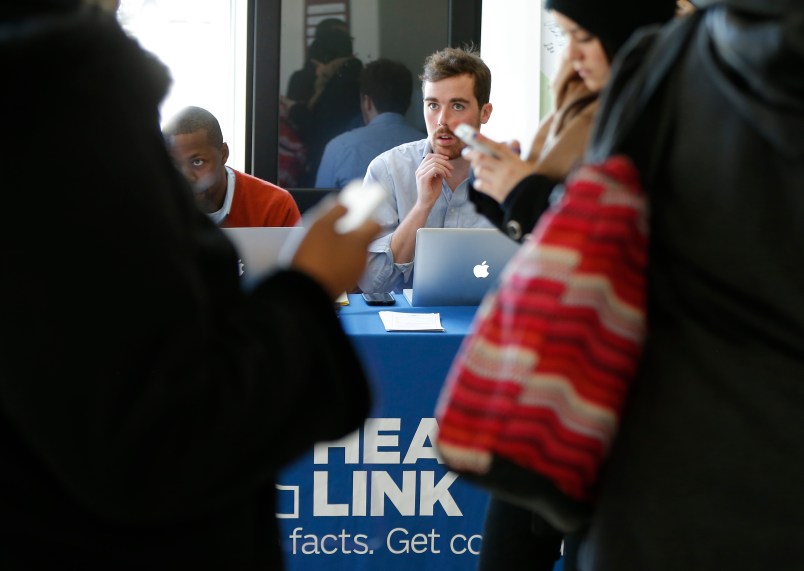WASHINGTON (AP) — “Do you guys have health insurance?” David Bransfield asks each time a group of college students passes by.
Nearly every day, Bransfield comes to a satellite campus of the University of the District of Columbia in the shadow of the Capitol, sitting for hours behind a table in the lobby of a classroom building.
With an Apple laptop and lots of fliers, he’s part of the army of workers and volunteers trying to enroll young, and probably healthy, people in health insurance available through President Barack Obama’s law.
Run largely by groups with close ties to the White House, the recruiting effort is based in part on lessons learned from Obama’s presidential races, which revolutionized the way campaigns tracked and targeted voters.
“On the campaign, you want to be able to find an Obama voter and you want to get them to vote,” said Matt Saniie, who worked on the 2012 campaign’s data team and is now analytics director at the organization Enroll America. “In the enrollment world, you want to find someone who is uninsured and you want to get them to enroll.”
More than any other group, participation from among the “young invincibles” — those ages 18 to 34 — will be crucial to the law’s success.
The Kaiser Family Foundation estimates that about 40 percent of those who enroll need to be young and healthy, to balance out the higher costs of insuring older, sicker people.
But less than two months before the March 31 sign-up deadline, the administration is lagging behind its goal.
Young adults made up about one-fourth of the 2.2 million people who enrolled in the exchanges through December, the last time the administration released demographic data.
Officials announced in mid-January that 3 million people had enrolled in insurance plans, but officials didn’t update the demographic details.
Critics of the law say young people were most likely to be turned off by the technical problems that marred the first two months of online sign-ups.
They also say some young people will opt to pay the penalty for not enrolling — $95, or 1 percent of income, whichever is higher — rather than pay more for coverage.
A December Gallup poll found that 26 percent of uninsured people under the age of 30 intended to pay the fine rather than enroll.
White House officials have minimized the slow enrollment by young people, saying they always expected those in their 20s and 30s to enroll toward the end of the six-month sign-up period.
Spokesman Jay Carney said young people are more likely to be deadline-driven and “late to the party when it comes to signing up.”
Megan Chapman is among the holdouts.
The 23-year-old college student from High Point, N.C., has been without health insurance for several years. She’s been thinking about signing up through the new federal marketplace but said she’s heard conflicting information about the costs, prompting her to do more research.
“It just depends on the price and how much financial aid I can get,” said Chapman, her laptop and spiral notebook spread out before her as she worked in the Guilford Technical Community College cafeteria in Jamestown, N.C. “I’m unemployed. I can’t pay a whole lot of money. So that will definitely be a major factor.”
As Chapman studied, a volunteer from Enroll America was going from table to table in the cafeteria, encouraging uninsured students to sign up.
The volunteer, retired dentist Benjamin Williams, 75, didn’t persuade Chapman to enroll, but he did get her to sign a card setting her up for a follow-up phone call to answer her health care questions.
With Chapman’s personal information now in Enroll America’s system, volunteers will almost certainly keep tabs on her enrollment status through March 31, mirroring the way the Obama campaign tracked likely Democratic voters.
Unlike the political campaign, in which staffers relied on voting records to track possible supporters, there’s no ready-made list of the uninsured. So outside groups are compiling their own databases through contacts their volunteers make while they’re promoting the health law at colleges, bars, church youth group events, and even laundromats.
Marlon Marshall, another veteran of Obama’s presidential campaigns, now oversees health care outreach efforts for the White House. He said the strategy for signing up young people it to “meet them where they’re at.”
The approach worked for Philippe Komongnan, 27, a student at the University of the District of Columbia.
Komongnan thought he had health insurance, but when a bad ear infection brought him to the emergency room last year, he was told he no longer had coverage. Because his school requires students to have insurance, he had to sign up for coverage through the college that costs nearly $700 per semester.
Then Komongnan started noticing a health care display in the lobby of his classroom building, the one where Bransfield works most days. After a couple of conversations, Bransfield plugged Komongnan’s information into Washington’s health care website and discovered that he qualified for Medicaid, which has been expanded under the new law.
While Komongnan’s costs will drop dramatically, he doesn’t count toward the pool of young and healthy people the White House is courting because he’s getting coverage through Medicaid, not the new private marketplace.
Bransfield, who works for the aptly named organization Young Invincibles, said signing up young people takes patience, given that most are buying insurance on their own for the first time. The process can sometimes take weeks, he said, as people collect the information they need to enroll or weigh the options available to them.
But the deadline has increased the pressure on Bransfield to get the students through the system faster.
“We’re trying to make sure it feels urgent,” he said.
___
Associated Press writer Skip Foreman in Jamestown, N.C., contributed to this report.
___
Follow Julie Pace on Twitter at http://twitter.com/jpaceDC






